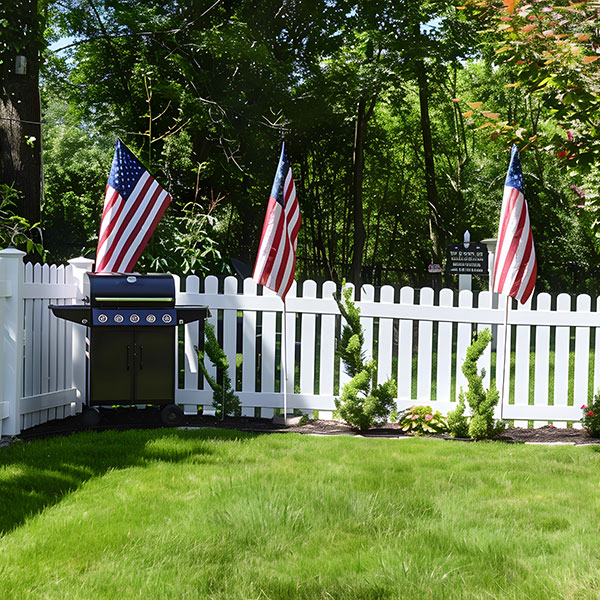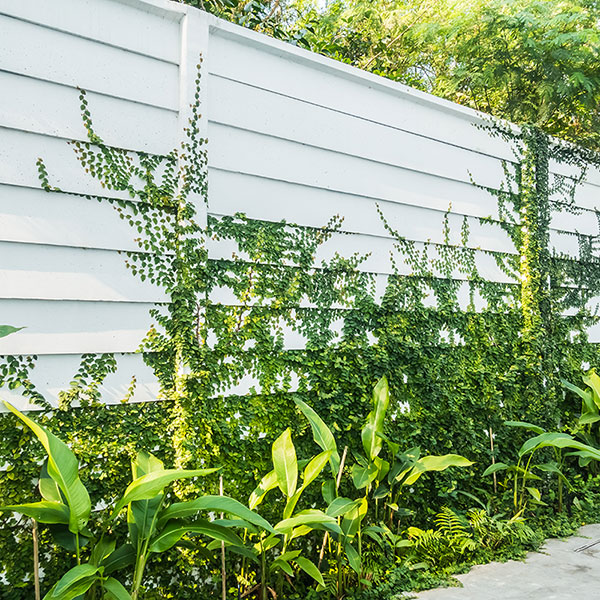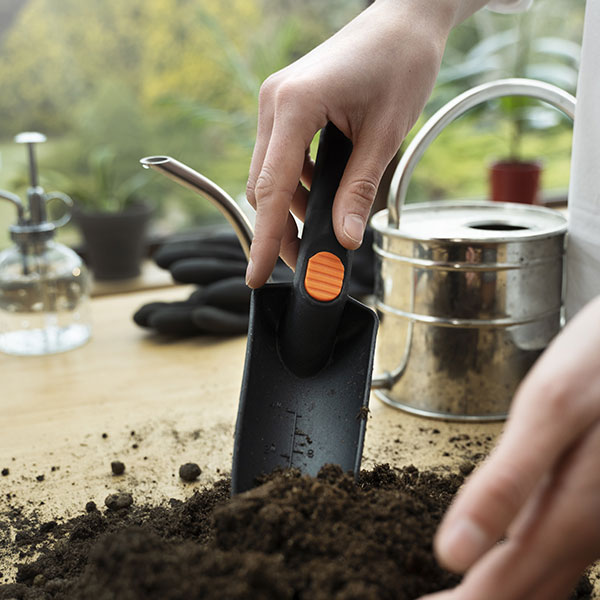How to Grow Plants Along a Vinyl Fence
Vinyl fences have become popular due to their low-maintenance qualities and durability. Made from polyvinyl chloride (PVC), these fences resist rotting, warping, and insect damage, which are common problems with wood fences.
Vinyl fences are easy to clean—often requiring just occasional rinsing with water to remove dirt or mildew. Unlike wood, they don’t need to be painted or stained regularly, and they are less prone to fading or cracking from sun exposure.
Their longevity and minimal upkeep make them a favorite choice for homeowners looking for an attractive, hassle-free fencing option.
Goals of this Guide
The main goal of this guide is to provide homeowners and gardeners with a clear, step-by-step approach to successfully growing plants along a vinyl fence.
Whether you’re aiming to enhance the visual appeal of your yard, add privacy, or create a natural, welcoming atmosphere, this guide will walk you through everything you need to know—from selecting the right plants and preparing the soil to installing supports for climbing vines and maintaining healthy growth.
By following these steps, you can transform a plain vinyl fence into a lush, beautiful garden feature.


Why Vinyl Fences Are Great for Gardeners
Durability
Vinyl fences are known for their exceptional durability and low-maintenance appeal.
Unlike wood or metal, vinyl is highly resistant to environmental factors like moisture, UV rays, and pests. This means it won’t rot, warp, rust, or become infested with insects, making it a long-lasting option for outdoor spaces.
Low-Maintenance
Vinyl fences are also incredibly low-maintenance. They don’t require regular painting, staining, or sealing, as their color is integrated into the material, preventing fading or peeling over time.
Cleaning is easy—typically, a quick rinse with a hose or light scrubbing with soap and water removes dirt, mold, or mildew. This hassle-free upkeep makes vinyl fences a top choice for homeowners seeking a durable and aesthetically pleasing fence that requires minimal effort to maintain.
Overall, their combination of strength, weather resistance, and ease of care makes vinyl fences a great long-term investment.
Beautiful Backdrop
Vinyl fences have a smooth, clean surface that provides an ideal neutral backdrop for showcasing plants.
Unlike wood or metal fences, which may have rough textures, visible knots, or rust, vinyl offers a sleek, uniform appearance. This smooth finish not only looks polished but also enhances the visual impact of plants, allowing their natural colors, shapes, and textures to stand out.
The neutral tones of most vinyl fences, typically white, beige, or light gray, make them versatile. These subtle colors don’t compete with the vibrant greens and colorful blooms of plants, letting the plants take center stage.
Additionally, the fence’s even surface creates a cohesive background that helps define the garden space, making the arrangement of plants more striking and organized.
A vinyl fence’s clean, neutral appearance complements the beauty of plants, elevating the overall aesthetics of your garden.
Choosing the Right Plants for Your Vinyl Fence
Plant selection for growing along a vinyl fence largely depends on the amount of sunlight the area receives throughout the day.
Here’s how different sunlight conditions influence your plant choices:
Full Sun
If your vinyl fence is in an area that receives direct sunlight for six or more hours a day, you’ll need to choose plants that thrive in full sun. These plants are typically drought-tolerant and can handle the intense heat. Popular options include:
- Sun-loving climbers like Clematis, Wisteria, and Morning Glory.
- Perennials and flowering plants such as Lavender, Coneflower, and Roses, which provide vibrant colors and blooms.
Partial Shade
Fences that receive 3-6 hours of sunlight per day fall into the partial shade category.
This lighting condition is ideal for plants that prefer some relief from the hot afternoon sun. These plants often tolerate a mix of sun and shade. Some great choices include:
- Climbing plants like Climbing Hydrangea or Ivy.
- Shrubs and flowers such as Astilbe, Coral Bells, and Japanese Forest Grass, which add texture and color without being sun-dependent.
Full Shade
If your fence is mostly shaded, receiving less than 3 hours of direct sunlight a day, you’ll need to choose shade-tolerant plants.
These plants are adapted to low light and often thrive in cooler, damp environments. Ideal choices include:
- Shade-loving vines like English Ivy or Virginia Creeper.
- Ground covers and perennials such as Hostas, Ferns, and Bleeding Hearts, which bring lush greenery and unique textures.
By assessing the sunlight exposure along your fence, you can ensure that the plants you choose will grow healthily and enhance the space, whether it’s bathed in sun or nestled in shade.


Soil testing for growing plants along a vinyl fence
How to Prepare the Soil Along a Vinyl Fence
Soil Testing
Checking soil quality and nutrient levels is crucial for the health and success of plants grown along a vinyl fence.
The condition of the soil directly impacts how well plants can absorb water, nutrients, and oxygen, all of which are essential for growth. Here’s why it’s important:
1. Nutrient Availability
Plants require a range of nutrients, including nitrogen, phosphorus, and potassium, to thrive. Testing the soil helps you determine if it has adequate levels of these essential nutrients.
Poor or depleted soil can lead to stunted growth, weak plants, and poor blooms. By assessing nutrient levels, you can amend the soil with organic matter, compost, or fertilizers as needed to create an optimal growing environment.
2. Soil pH Balance
Soil pH affects how plants absorb nutrients. Some plants prefer slightly acidic soil, while others thrive in more neutral or even alkaline conditions.
Testing the pH allows you to adjust the soil if necessary, ensuring that plants can access the nutrients present in the soil.
For example, if your soil is too acidic, adding lime can raise the pH, while sulfur can help lower it if it’s too alkaline.
3. Drainage and Aeration
The texture and structure of the soil influence drainage and root health.
Poor drainage can lead to waterlogged soil, which causes root rot, while overly sandy soil may drain too quickly, depriving plants of moisture.
Testing for soil composition (sand, silt, and clay levels) allows you to improve drainage and aeration by incorporating organic material like compost or peat moss to achieve the right balance.
4. Root Development
Healthy roots are essential for strong plant growth along vinyl fencing, and nutrient-rich, well-draining soil encourages deeper root development.
Deep roots allow plants to access water and nutrients more effectively and help them anchor firmly in the ground, which is especially important for plants growing along a fence that may be exposed to wind or other elements.
5. Long-Term Growth and Stability
Checking soil quality before planting ensures that you’re creating a long-lasting, sustainable growing environment for your plants.
Properly prepared soil will support not only the initial growth phase but also the long-term health and vitality of your plants, preventing the need for constant replanting or intensive care.
By testing and improving soil quality along your vinyl fence, you give your plants the best possible foundation for healthy growth, allowing them to flourish and enhance the beauty of your garden.
Soil testing for growing plants along a vinyl fence
Planning and Spacing Your Plants
Proper planning and spacing of your plants along a vinyl fence are essential to creating a balanced, healthy garden.
Before planting, consider the mature size of each plant, ensuring they have enough room to grow without overcrowding. This prevents competition for sunlight, water, and nutrients while also reducing the risk of disease.
Taller plants or climbing vines should be placed closer to the fence, allowing them to use the structure for support, while shorter plants can be positioned in front to create a layered effect.
It’s also important to plan for airflow between plants to promote healthy growth and reduce humidity buildup, which can lead to fungal issues.
Thoughtful spacing not only keeps your plants thriving but also enhances the visual appeal of your garden by preventing overgrowth and maintaining a well-organized, attractive landscape.
Tips on designing the layout for a balanced look—placing taller plants near the vinyl fence and shorter ones at the front.
Here are a few tips for designing a balanced plant layout along a vinyl fence:
Create a Tiered Effect:
Place taller plants, shrubs, or climbing vines closest to the fence to form a natural backdrop. This provides a sense of height and depth. Then, gradually step down in height by positioning medium-sized plants or bushes in the middle, and finally, place low-growing flowers or ground covers at the front.
This tiered arrangement ensures that every plant is visible and has access to sunlight.
Vary Plant Textures and Shapes:
Combine plants with different leaf textures and shapes to add interest and dimension. For example, pair spiky plants like ornamental grasses near the fence with softer, rounder plants like hydrangeas or hostas in front. This creates visual contrast and prevents a flat or monotonous look.
Use Repetition for Cohesion:
Repeating certain plants or color schemes along the length of the fence can create a sense of flow and unity in the garden. This helps avoid a cluttered or random appearance, making the overall design look intentional and balanced.
Mind the Plant Spacing:
Ensure that plants have enough room to grow to their mature size without overlapping or overshadowing one another. This keeps the layout clean and prevents crowding, which can detract from the aesthetic and harm plant health.
Add Vertical Interest:
Consider using trellises or arbors for climbing plants along the fence to enhance vertical space. This draws the eye upward, making the layout more dynamic, especially in smaller spaces.
These design strategies can help you create a balanced, layered garden that complements your vinyl fence while allowing each plant to shine.


Caring for Your Plants Along a Vinyl Fence
Watering plants grown along a vinyl fence requires a balance between providing enough moisture for healthy growth and avoiding overwatering, which can lead to root rot or other issues.
Watering Plants Along a Vinyl Fence
Here are some best practices for watering plants in this setting:
Know Your Plants’ Water Needs:
Different plants have varying water requirements. For example, drought-tolerant plants like succulents or lavender need less frequent watering, while thirsty plants like hydrangeas or certain vines need more. Research each plant’s needs to avoid over- or under-watering.
Water Deeply, Not Frequently:
Instead of light surface watering, provide deep watering sessions that allow moisture to penetrate the soil and reach the roots. This encourages deeper root growth, making plants more resilient. Watering deeply every few days is typically better than shallow watering every day.
Morning Watering Is Best:
Water in the early morning when temperatures are cooler and winds are lighter. This allows water to be absorbed before it evaporates under the heat of the sun, giving plants time to soak up the moisture.
Consider Drip Irrigation or Soaker Hoses:
Installing drip irrigation systems or using soaker hoses along the fence line ensures a slow, steady supply of water directly to the root zone. These methods minimize water waste, reduce evaporation, and help keep leaves dry, reducing the risk of fungal diseases.
Monitor Drainage:
Ensure that water drains properly along the fence line, as vinyl fences may limit airflow or sunlight in certain areas, potentially leading to soggy soil. Improve drainage with organic material, like compost, and avoid overwatering, especially in low-lying or shaded spots.
Mulch to Retain Moisture:
Adding a layer of mulch around the base of your plants helps retain soil moisture, reduces evaporation, and keeps the soil cooler during hot weather. Organic mulch also enriches the soil as it breaks down.
By following these watering best practices, you can keep your plants along the vinyl fence healthy and thriving without risking root damage or water stress.
Pruning and Maintenance
Pruning and maintenance are essential for keeping plant growth in check and preventing overgrowth that could potentially damage your vinyl fence.
Regular trimming not only promotes healthy plant growth but also helps maintain the aesthetics of both your plants and the fence. Here are some key points on how to properly manage plant growth:
Prune Regularly for Shape and Size Control:
Many plants, especially fast-growing vines or shrubs, can quickly become overgrown if not pruned regularly. Trim back any branches, stems, or vines that begin to encroach on the fence or nearby plants. This keeps them well-shaped and prevents them from overcrowding.
Cut Back Climbing Vines:
Vines like Clematis, Wisteria, or Morning Glory can easily grow out of control if left unattended. Prune excess growth and remove any tendrils that may wind around fence posts or joints, which could eventually damage the vinyl. Aim to direct their growth along trellises or supports rather than directly on the fence.
Remove Dead or Damaged Growth:
Regularly inspect plants for dead, damaged, or diseased branches. Removing these not only keeps the plants healthy but also prevents debris from accumulating against the fence, which could cause moisture buildup or mildew over time.
Keep Bushes and Shrubs Trimmed Back:
If you have bushes or shrubs planted along the base of the fence, maintain a neat shape by trimming them back. Overgrown branches can press against the fence, potentially scratching or staining the vinyl. Trimming keeps plants from becoming top-heavy or growing too wide.
Ensure Proper Air Circulation:
Overgrown plants can block airflow along the fence line, which may lead to humidity buildup or mildew growth on the fence surface. Prune dense foliage to allow for better air circulation, which benefits both the plants and the fence.
Use the Right Tools and Techniques:
Use sharp, clean pruning shears or hedge trimmers to make clean cuts. This prevents jagged edges that can damage the plant or lead to disease. For climbing plants, cut back excess growth at the start of each growing season to promote healthier, more controlled expansion.
By pruning and maintaining your plants regularly, you’ll not only keep them from damaging the vinyl fence but also enhance their health and appearance, ensuring a balanced and beautiful garden.
Elevation
Elevation can significantly affect plant growth along a vinyl fence due to its impact on sunlight exposure, temperature, drainage, and wind patterns. Here’s how different elevation factors play a role:
Sunlight Exposure:
Elevation changes can alter how much sunlight your plants receive. Higher elevations may expose plants to more intense sunlight, especially if the fence is situated on a hill or slope. This increased light can benefit sun-loving plants but may require shade-tolerant plants to be placed lower where they get partial or indirect sunlight.
Temperature Fluctuations:
In higher elevations, temperatures tend to be cooler, and nights can get colder, which may slow plant growth or cause frost damage to sensitive species. At lower elevations, temperatures are usually warmer, creating a more conducive environment for a wider range of plants. Choose plants that are suited to the specific temperature ranges at your fence’s elevation.
Drainage:
Water naturally flows downhill, so plants at a lower elevation near the base of the fence may receive more water, leading to potential over-saturation of the soil and root rot. Conversely, plants at higher elevations may experience faster drainage and may require more frequent watering. It’s essential to monitor moisture levels and consider installing proper drainage systems like trenches or mulch to control water flow.
Wind Exposure:
Elevation can increase wind exposure, particularly on slopes or open areas. Wind can dry out plants more quickly and cause damage to delicate branches or flowers. If your fence is located in a high-elevation area with frequent winds, consider adding windbreaks or choosing sturdier, wind-resistant plants.
Soil Erosion:
Elevation changes can lead to soil erosion, especially in sloped areas. Water runoff can wash away soil at lower elevations, leaving plants with exposed roots or nutrient-poor soil. To prevent this, add ground covers, mulch, or erosion control fabric to stabilize the soil along the fence.
By understanding how elevation affects factors like sunlight, water, and wind, you can select the right plants and implement strategies to manage these conditions, ensuring healthy growth along your vinyl fence.
Click to learn more about Denver vinyl fencing.
Common Problems with Growing Plants Along a Vinyl Fence and How to Fix Them
Growing plants along a vinyl fence can present a few common problems, but with the right approach, you can address and fix them effectively. Here are some issues you may encounter and how to solve them:
1. Overgrowth and Plant Damage to the Fence
Problem: Fast-growing plants, especially vines, shrubs, or aggressive climbers, can become overgrown and may attach themselves to the vinyl fence. Over time, this can lead to scratches, staining, or structural pressure on the fence.
Solution: Regular pruning is the key to preventing overgrowth. Trim plants to control their size and prevent them from clinging directly to the fence. Installing trellises or plant supports slightly away from the fence can guide growth without letting vines or branches come into direct contact with the vinyl.
2. Pests and Insects
Problem: Plants growing near fences can attract pests like aphids, ants, or beetles, which may harm the plants and make maintenance more difficult. These insects can also bring fungal diseases, which can affect plant health and soil quality.
Solution: Inspect plants regularly for signs of pests, such as chewed leaves or sticky residue. Introduce natural predators like ladybugs, use organic insecticides, or create barriers such as horticultural oils to keep pests at bay. Keeping plants well-spaced can also help improve airflow and reduce the likelihood of infestations.
3. Staining or Mildew Growth on the Fence
Problem: Plants growing too close to the fence can trap moisture, leading to mildew or mold growth on the vinyl. In addition, some plants may release sap or tannins that can stain the fence over time.
Solution: Ensure proper airflow between the plants and the fence by spacing them appropriately and pruning excess foliage. For any stains, clean the vinyl fence regularly using a mixture of mild detergent and water or a specialized vinyl fence cleaner. Avoid plants that release sticky substances or install protective mesh between the plants and the fence.
4. Soil Erosion Near the Fence Line
Problem: Improper watering, poor drainage, or lack of ground cover can lead to soil erosion near the base of the fence. This can expose plant roots, harm plant growth, and weaken the stability of the plants.
Solution: Incorporate ground covers or mulch to stabilize the soil along the fence line. Additionally, consider adjusting your irrigation method, such as using drip irrigation, to avoid washing away soil. Adding organic matter like compost can also improve soil structure and prevent erosion.
5. Insufficient Sunlight for Plants
Problem: Depending on the location of your vinyl fence, parts of your garden may receive limited sunlight, especially in shaded corners or where the fence blocks the light. This can stunt the growth of sun-loving plants.
Solution: Choose plants based on the sunlight conditions along the fence line. If parts of the fence receive full shade, opt for shade-tolerant plants like ferns, hostas, or ivy. For sunnier sections, select plants that thrive in full sun. Consider moving plants if they seem to struggle due to lack of light.
6. Watering Challenges
Problem: Plants near fences may not receive adequate water due to drainage issues or awkward placement. This can lead to dry soil and poor plant growth.
Solution: Use drip irrigation or soaker hoses along the base of the fence to ensure consistent watering directly to the roots. Monitor moisture levels regularly and adjust watering depending on plant needs and soil drainage conditions.
By addressing these common problems with practical solutions, you can ensure that both your plants and your vinyl fence stay in top condition, contributing to a healthy, attractive garden environment.


Final Thoughts
Benefits of Growing Plants Along a Vinyl Fence
Growing plants along a vinyl fence offers a range of benefits that enhance both your garden’s aesthetics and functionality.
First, the smooth, clean surface of a vinyl fence provides a neutral backdrop that highlights the natural beauty of the plants, creating a visually appealing contrast.
Plants can soften the rigid lines of the fence, blending man-made structures with nature for a more harmonious landscape.
Additionally, planting along a vinyl fence can improve privacy, as tall plants or climbing vines can act as a natural screen, offering more seclusion.
The durable, low-maintenance nature of vinyl means you won’t have to worry about the fence deteriorating from moisture or plant growth, and it requires minimal cleaning to keep looking new.
Lastly, with proper plant selection and care, you can create a lush, vibrant space that adds texture, color, and life to your garden, all while utilizing the vertical space along the fence.
Experimentation
Don’t be afraid to experiment with different plant varieties to find the perfect mix that works best for your garden.
Every yard is unique, and factors like sunlight, soil conditions, and climate can greatly influence which plants thrive along your vinyl fence.
Start by trying a variety of plants—climbers, shrubs, flowers, and ground covers—then observe how they perform in your specific environment.
Over time, you’ll discover which combinations create the most visually appealing and healthy garden.
Experimentation also allows you to mix in seasonal plants or swap out species as your preferences evolve, ensuring your garden remains fresh and vibrant year after year.
